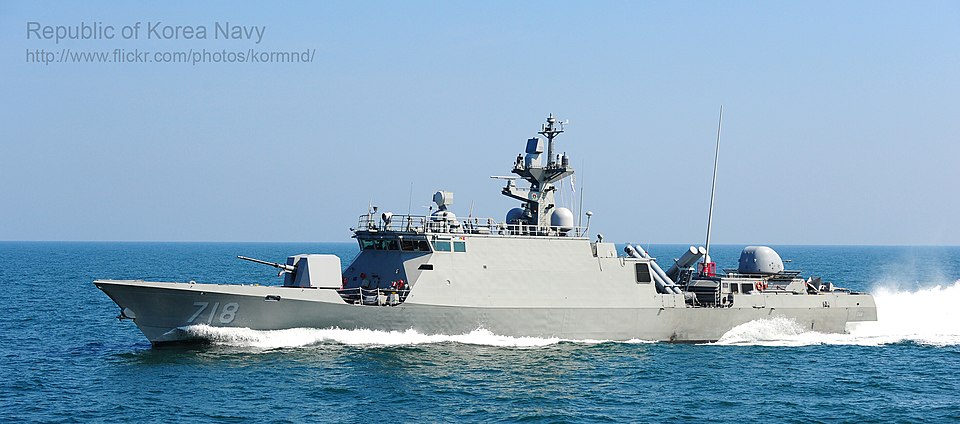The world’s seas are getting busier and messier. While great-power navies are concentrating their deployment of high-end destroyers and submarines in contested areas, the increasing trend of gray-zone pressure, illegal fishing, and hybrid attacks is adding another layer of maritime threat. Such a mismatch has created a vacuum in daily maritime security, leaving space that Offshore Patrol Vessels (OPVs) could uniquely fill.
While geopolitical conflicts are expanding from the Western Pacific to the Red Sea, frontline fleets must deploy the most capable warships in flashpoints to deter a near-peer adversary. That leaves fewer platforms available for constabulary missions such as EEZ patrol, anti-piracy, search and rescue, and maritime interdiction. At the same time, especially in Asia, coast guards and paramilitary organizations are operating more assertively. For example, the Chinese coast guard and maritime militia have become central to gray-zone tactics that aim to change facts at sea while avoiding a full-fledged maritime response from neighboring countries. In such an environment, the OPV’s blend of law enforcement authority, endurance, and scalable lethality has become a necessity rather than a luxury.
Why OPVs, and Why Now?
At just a fraction of a destroyer’s procurement and operating cost, OPVs can deliver persistent presence. This aspect is important for a number of Southeast Asian countries facing growing mission lists and tight budgets. The Philippines’ decision to introduce six OPVs from a South Korean shipbuilder can be understood in this context: more hulls mean more days at sea and better coverage of its vast archipelago. Malaysia and Indonesia have also prioritized patrol vessels and light combatants to cover wide maritime zones, reserving their high-end platforms for emergencies.
OPVs show their strengths where missions are legally complex and multifaceted. They can take the lead in fisheries enforcement, anti-smuggling, and presence operations. Furthermore, OPVs can enhance their firepower through modular weapons when missions become “heated,” and they can help manage escalation situations. Meanwhile, OPVs are increasingly designed as motherships for unmanned systems. Equipped with flight decks, mission bays, and boat ramps, OPVs can deploy and recover UAVs and USVs, extending surveillance and response ranges without risking crews on deck.
Meeting Manpower and Technology Realities
Demographic and recruitment challenges are shifting platform design. For example, Japan and South Korea face chronic recruitment shortfalls that complicate plans for manpower-intensive platforms. OPVs are well suited to this reality. Recent designs use integrated masts, automation, and condition-based maintenance (CBM), which allow operational tempo to be sustained while reducing crew numbers. If coupled with manned-unmanned teaming (MUM-T)—for example, a patrol vessel controlling a swarm of small drones for wide-area ISR—the platform’s coverage would be significantly expanded, going far beyond their crew size.
A new generation of OPVs combines affordability, modular design, and readiness for manned–unmanned teaming. Such ships could be adapted across coalition navies and coast guards. Instead of expensive retrofits, open-architecture systems allow sensors and combat suites to be upgraded easily. Containerized mission modules—from drones to electronic warfare packages—let a single ship switch between law enforcement and higher-end deterrence. Automation reduces crew demands, while space is reserved for additional weapons if the security environment worsens. In short, these OPVs provide flexibility at a cost and manpower level that many countries can sustain.
Filling the Gray-Zone Vacuum Without Burdening the Budget
All of the above arguments do not oppose procuring destroyers; they argue against using destroyers for tasks better suited to OPVs. If the bulk of high-end vessels’ time is consumed chasing trawlers, escorting merchantmen, or warning off paramilitary maritime vessels, deterrence in other areas would be weakened. OPVs allow navies to economize presence: displaying flags, enforcing the law, and building partner capacity on a daily basis, while freeing destroyers and other large platforms to focus on deterrence and, if necessary, combat missions.
Southeast Asia illustrates these opportunities well. Maritime conflicts persist in the South China Sea, where ramming, water cannons, and dangerous maneuvers have become common. Although many countries in the region urgently need more naval platforms, they lack the means to fill the gap solely with high-end vessels. In that context, OPVs—solidly networked with robust communications and domain awareness—offer an affordable way to expand maritime control on a daily basis, supported by coast guards’ legal authorities and navies’ escalation options.
The Korean Industrial Path: Amalgam of Ships and Systems
Delivering a “future OPV” requires more than just a hull. Substantial integration with electronics and combat systems is essential. In this sense, South Korea’s defense and shipbuilding industries are in a strong position. South Korean shipyards already export patrol boats and light combatants, and the Philippines’ OPV program is one example of a cost-effective package sourced from Korea. On the systems side, South Korea’s combat management system (CMS) is already in service with several regional navies, including the Philippines, demonstrating integration experience across foreign sensors and weapons.
Going further, South Korea is designing and manufacturing an OPV through a company well known for its world-class electronics and combat systems—Hanwha Systems. This means the future OPV would be designed and built from the standpoint of harmonized electronics and combat systems, including MUM-T and anti-drone capabilities. Such a unique approach could modularize many of the OPV’s key components, allowing customization and delivery tailored to each region’s specific needs.
Policy Implications and Practical Roadmap
To meet current maritime demands and force-structure realities, defense planners and finance ministers should take the following three measures:
First, OPV fleets should be built for gray-zone operation including sovereignty patrols (SOVPATS), search and rescue, sanctions enforcement, and maritime policing while reserving destroyers and frigates for deterrence patrols and combined exercises.
Second, OPVs should be design for MUM-T from the start by specifying boat bays, UAV hangar space, high-capacity power and cooling, and control stations for unmanned systems, thereby lowering the barrier to fielding small, attritable drones that expand coverage and decision-making advantages.
Third, open systems and modular payloads should be adopted by using open standards so partners can integrate national radios, data links, and weapons while rewarding vendors that deliver software-defined upgrades and containerized mission kits instead of expensive bespoke refits.
For U.S. allies, such an approach aligns with the principle of division of labor. While a networked tier of OPVs heightens day-to-day resilience in the first and second island chains, it would support interdictions in chokepoints and strengthen the maritime commons against gray-zone coercion. At the same time, it would allow high-end vessels to focus where they matter most.
Conclusion
The next decade at sea will be defined as much by everyday competition as by headline crises. A low-cost, modular, MUM-T-capable OPV is the most appropriate hull for such tasks. Countries that cannot afford destroyers still need reliable naval presence and deterrence. With mature C4ISR and shipbuilding ecosystems, South Korean industry provides a practical pathway to fielding those capabilities at scale. If pursued properly, OPVs would go beyond simply filling a vacuum—they would serve as a backbone of maritime security in the gray-zone era.
[Photo by 대한민국 국군 Republic of Korea Armed Forces, CC BY-SA 2.0, via Wikimedia Commons]
The views and opinions expressed in this article are those of the author.

Dr. Ju Hyung Kim currently serves as the president at the Security Management Institute, a defense think tank affiliated with the South Korean National Assembly. He has been involved in numerous defense projects and has provided consultation to several key organizations, including the Republic of Korea Joint Chiefs of Staff, the Defense Acquisition Program Administration, the Ministry of National Defense, the Korea Institute for Defense Analysis, the Agency for Defense Development, and the Korea Research Institute for Defense Technology Planning and Advancement. He holds a doctoral degree in international relations from the National Graduate Institute for Policy Studies (GRIPS) in Japan, a master’s degree in conflict management from the Johns Hopkins University School of Advanced International Studies (SAIS), and a degree in public policy from Seoul National University’s Graduate School of Public Administration (GSPA).

